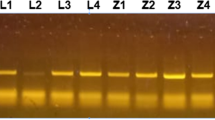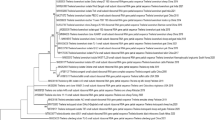Abstract
Wildlife, especially Cape buffalo (Syncerus caffer), are thought to act as a reservoir for many of the important tick-borne pathogens of cattle. In this study, we have determined the prevalence of the most significant tick-borne haemoparasites in wildlife (buffalo, impala, eland and bushbuck) as well as in cattle grazing inside and neighbouring Lake Mburo National Park (LMNP) in Uganda. A high percentage of buffalo were carriers of Theileria parva, Theileria mutans, Theileria velifera, Theileria buffeli and Theileria sp. (buffalo) as well as Anaplasma marginale and Anaplasma centrale. The majority of impala sampled were carriers of A. centrale, and all were carriers of an unidentified Babesia/Theileria species. The eland and bushbuck sampled were all carriers of Theileria taurotragi and Theileria buffeli, and the majority were carriers of T. mutans. The bushbuck sampled were also carriers for Erhlichia bovis. There were some differences in the prevalence of haemoparasites between the calves sampled inside and neighbouring LMNP. In order to address the question of whether there is evidence for interbreeding between buffalo-associated and cattle-associated T. parva populations, multi-locus genotypes (MLGs) of T. parva (based on micro-satellite markers) from buffalo and from calves grazing inside and outside LMNP were compared, and the results revealed that buffalo and cattle gene pools were distinct, showing no evidence for transmission of buffalo-derived T. parva genotypes to the cattle population.






Similar content being viewed by others
References
Allsopp BA, Baylis HA, Allsopp MT, Cavalier-Smith T, Bishop RP, Carrington DM, Sohanpal B, Spooner P (1993) Discrimination between six species of Theileria using oligonucleotide probes which detect small subunit ribosomal RNA sequences. Parasitology 107(Pt 2):157–165
Bekker CP, de Vos S, Taoufik A, Sparagano OA, Jongejan F (2002) Simultaneous detection of Anaplasma and Ehrlichia species in ruminants and detection of Ehrlichia ruminantium in Amblyomma variegatum ticks by reverse line blot hybridization. Vet Microbiol 89:223–238
Bishop RP, Spooner PR, Kanhai GK, Kiarie J, Latif AA, Hove T, Masaka S, Dolan TT (1994) Molecular characterization of Theileria parasites: application to the epidemiology of theileriosis in Zimbabwe. Parasitology 109(Pt 5):573–581
Collins NE, Allsopp BA (1999) Theileria parva ribosomal internal transcribed spacer sequences exhibit extensive polymorphism and mosaic evolution: application to the characterization of parasites from cattle and buffalo. Parasitology 118(Pt 6):541–551
Epstein H (1971) On the classification of cattle. The origin of domestic animals of Africa. African Publishing Corporation, New York, p 187
Geysen D, Bazarusanga T, Brandt J, Dolan TT (2004) An unusual mosaic structure of the PIM gene of Theileria parva and its relationship to allelic diversity. Mol Biochem Parasitol 133:163–173
Grootenhuis JG, Morrison WI, Karstad L, Sayer PD, Young AS, Murray M, Haller RD (1980) Fatal theileriosis in eland (Taurotragus oryx): pathology of natural and experimental cases. Res Vet Sci 29:219–29U
Grootenhuis JG, Leitch BL, Stagg DA, Dolan TT, Young AS (1987) Experimental induction of Theileria parva lawrencei carrier state in an African buffalo (Syncerus caffer). Parasitology 94(Pt 3):425–431
Gubbels JM, de Vos AP, van der Weide M, Viseras J, Schouls LM, de Vries E, Jongejan F (1999) Simultaneous detection of bovine Theileria and Babesia species by reverse line blot hybridization. J Clin Microbiol 37:1782–1789
Jaccard P (1908) Nouvelles recherches sur la distribution florale. Bull Soc Vaud Sci Nat 44:223–270
Lawrence JA (1979) The differential diagnosis of the bovine theilerias of Southern Africa. J S Afr Vet Assoc 50:311–313
Maritim AC, Kariuki DP, Young AS, Mutugi JJ (1989a) The importance of the carrier state of Theileria parva in the epidemiology of theileriosis and its control by immunization. In: Dolan TT (ed) Theileriosis in Eastern, Central and Southern Africa. International Laboratory for Research on Animal Diseases, Nairobi, pp 121–128
Maritim AC, Young AS, Lesan AC, Ndungu SG, Mutugi JJ, Stagg DA (1989b) Theilerial parasites isolated from carrier cattle after immunization with Theileria parva by the infection and treatment method. Parasitology 99(Pt 1):139–147
Norval RA, Lawrence JA, Young AS, Perry BD, Dolan TT, Scott J (1991) Theileria parva: influence of vector, parasite and host relationships on the epidemiology of theileriosis in southern Africa. Parasitology 102(Pt 3):347–356
Norval RA, Perry BD, Young AS (1992) The epidemiology of theileriosis in Africa. Academic, London
Oura CA, Odongo DO, Lubega GW, Spooner PR, Tait A, Bishop RP (2003) A panel of microsatellite and minisatellite markers for the characterisation of field isolates of Theileria parva. Int J Parasitol 33:1641–1653
Oura CA, Bishop R, Wampande EM, Lubega GW, Tait A (2004a) The persistence of component Theileria parva stocks in cattle immunized with the ‘Muguga cocktail’ live vaccine against East Coast fever in Uganda. Parasitology 129:27–42
Oura CA, Bishop RP, Wampande EM, Lubega GW, Tait A (2004b) Application of a reverse line blot assay to the study of haemoparasites in cattle in Uganda. Int J Parasitol 34:603–613
Oura CA, Asiimwe BB, Weir W, Lubega GW, Tait A (2005) Population genetic analysis and sub-structuring of Theileria parva in Uganda. Mol Biochem Parasitol 140:229–239
Page RD (1996) TreeView: an application to display phylogenetic trees on personal computers. Comput Appl Biosci 12:357–358
Perry BD, Young AS (1995) The past and future roles of epidemiology and economics in the control of tick-borne diseases of livestock in Africa: the case of theileriosis. Prev Vet Med 25:107–120
Potgieter FT, Stoltsz WH, Blouin EF, Roos JA (1988) Corridor disease in South Africa: a review of the current status. J S Afr Vet Assoc 59:155–160
Wright S (1921) Systems of mating. Genetics 6:111–178
Young AS, Purnell RE (1973) Transmission of Theileria lawrencei (Serengeti) by the ixodid tick, Rhipicephalus appendiculatus. Trop Anim Health Prod 5:146–152
Young AS, Brown CG, Burridge MJ, Cunningham MP, Kirimi IM, Irvin AD (1973) Observations on the cross-immunity between Theileria lawrencei (Serengeti) and Theileria parva (Muguga) in cattle. Int J Parasitol 3:723–728
Acknowledgements
C.A.L. Oura was funded by a Tropical Research Fellowship from the Wellcome Trust.
We are grateful to the Uganda Wildlife Authority (UWA) for collecting the blood samples from the buffalo in LMNP in Uganda We are especially thankful to Joseph Okori from UWA for his help and we would like to thank the PACE programme for allowing us access to the buffalo blood samples for this study. We are grateful to staff in Uganda for collecting the blood samples and to Dr. Richard Bishop, ILRI, Kenya for providing some of the tissue culture isolate DNA.
Author information
Authors and Affiliations
Corresponding author
Rights and permissions
About this article
Cite this article
Oura, C.A.L., Tait, A., Asiimwe, B. et al. Theileria parva genetic diversity and haemoparasite prevalence in cattle and wildlife in and around Lake Mburo National Park in Uganda. Parasitol Res 108, 1365–1374 (2011). https://doi.org/10.1007/s00436-010-2030-8
Received:
Accepted:
Published:
Issue Date:
DOI: https://doi.org/10.1007/s00436-010-2030-8




